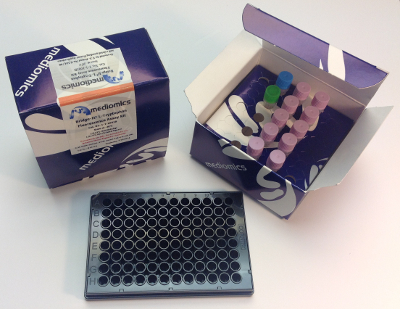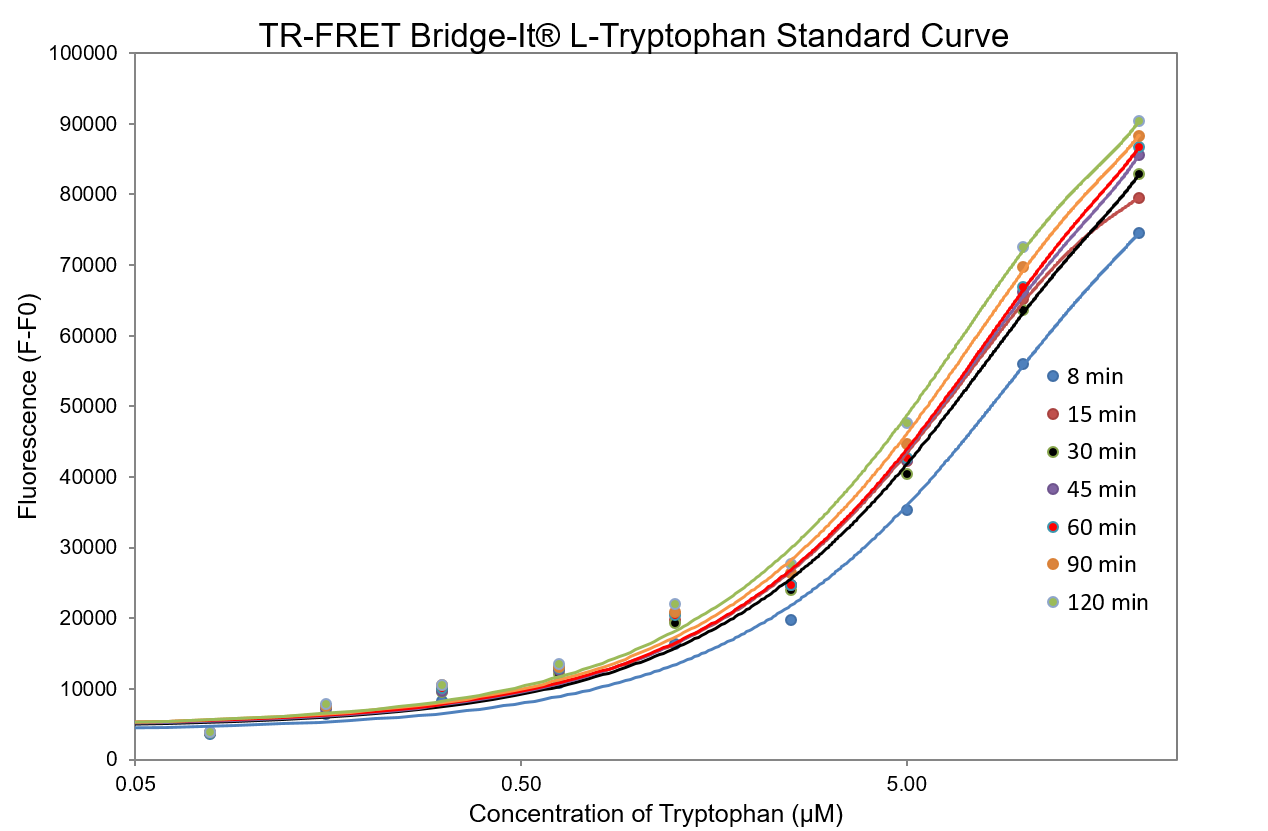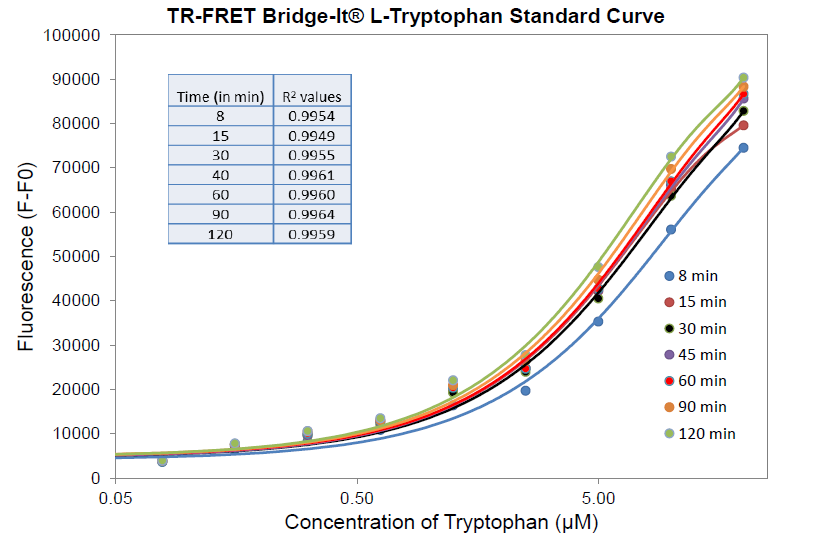TR-FRET Bridge-It® L-Tryptophan Fluorescence Assay Kit, 96-well format
The Bridge-It® tryptophan fluorescence assay is based on the activity of tryptophan repressor protein (TrpR), a bacterial DNA-binding protein. TrpR protein binds to its DNA-binding site in tryptophan-dependent fashion.
The central feature of this assay design is the TrpR-dependent association of two fluorochrome-labeled DNA half-fragments (one labeled with fluorescein and the other labeled with Oyster® 645 fluophore). Each fragment contains about one-half of the TrpR protein DNA-binding site. In the presence of L-tryptophan an increase in fluorescence signal can be detected as a result of the tryptophan-dependent association of the labeled DNA half-fragments. Tryptophan is readily detectable using the Bridge-It® tryptophan fluorescence assay in various types of test samples including bacterial growth medium, brain extract, yeast extract, as well as in human serum and urine.
$220.00 – $400.00
Description
TR-FRET Bridge-It® L-Tryptophan Fluorescence Assay Kit, 96-well format
Applications
- Quantification of Tryptophan levels in biological fluids, cell culture and fermentation medium, and extracts of tissues and cells.
- Measurement of total tryptophan and free tryptophan in samples
- High throughput screening for drug discovery (please contact us for bulk discount pricing)
- Diet and nutrition, mental health, and immunology studies
Features
-
Easy: Mix test sample or standard with the Assay solution and incubate at ~25°C. No wash steps!
-
Fast: Read fluorescent signal after 30 minutes of incubation (95% complete after 8 minutes)
-
Sensitive: Assay measures tryptophan at a lower limit of detection of 0.078 µM
-
Flexible: Assay is available in FRET and TR-FRET format, and can be adapted to colorimetric format upon request
-
Specific: No cross reactivity with other standard amino acids or Kynurenine
-
Highly Reproducible : Measure total tryptophan in serum and plasma samples with high reproducibility and accuracy
-
High Signal to Background Ratio: TR-FRET option of the Bridge-It® Assay kit gives very high signal to background ratio (15+ fold) which is useful for high throughput screening and drug discovery
Pricing: The 50-well kit is a one-time trial purchase. For bulk pricing options, please contact us. For any other questions or comments, please do not hesitate to contact us. We are always happy to help!
Background Information on Tryptophan and the TR-FRET Bridge-It® Fluorescence Assay
L-Tryptophan
L-tryptophan (tryptophan) is one of eight essential amino acids that must be obtained from the diet. Tryptophan serves as a key building block for synthesis of proteins and as a precursor for various brain neurotransmitters including serotonin. Tryptophan is the only recognized precursor that can be converted into serotonin by the body. Serotonin promotes feelings of well-being and calm and thereby helps to counterbalance the physiological effects of brain dopamine and the nor-adrenaline circuits which encourage fear, anger, tension, aggression, obsessive-compulsive actions, over-eating (especially of carbohydrates), migraine headache, depression, and sleep disturbances. Melatonin, a metabolite of serotonin, is a sleep promoting natural hormone made by the pineal gland. In addition, tryptophan is a key precursor for niacin (vitamin B3), a vitamin that is essential for normal respiration, metabolism, and synthesis of sex hormones. Because tryptophan plays such a critical role in the proper balancing of metabolism, mood and sleep patterns, insufficient dietary availability of this essential amino acid can lead to serious adverse consequences.
TR-FRET Bridge-It® L-Tryptophan Fluorescence Assay
Eukaryotic cells contain an estimated 3,000 sequence-specific DNA binding proteins. These important proteins, acting either with or without a specific small molecule coregulator (ligand), control all aspects of genomic DNA activity including gene expression, DNA replication, and DNA repair. Mediomics is applying its novel fluorescence assay platform to develop in vitro assays useful for rapidly and sensitively quantifying the activity of both DNA binding proteins and their small molecule ligands.
The common property of all sequence-specific DNA binding proteins is their ability to bind with high affinity and specificity to a DNA duplex containing a unique nucleotide sequence- i.e. the DNA binding site for the protein.
Mediomics’ novel assay platform relies on this common characteristic. A DNA duplex containing the sequence-specific DNA binding site for a given target DNA-binding protein is split into two DNA “half-site” duplexes each having a short single-stranded overhang. These single-stranded extensions are short enough so that in the absence of the target protein little spontaneous re-association occurs. When the target protein is present, however, its high affinity for the full-length DNA sequence will drive the re-association of the two half-site DNA duplexes. This re-association can be sensitively detected by incorporating a two fluorophore system [a donor (Eu3+) and an acceptor] into each of the two DNA half-sites. In this assay, the DNA binding protein acts as a biosensor for its specific ligand (Trp). The ligand binds to the DNA binding protein, activating the binding site by a conformational change. The presence of the activated DNA binding protein is detected as an increase in fluorescence signal of the acceptor fluorophore or as a decrease in fluorescence signal of the donor fluorophore as a result of Time Resolved fluorescence resonance energy transfer (TR-FRET) between the two fluorophores.
Tryptophan is readily detectable using the TR-FRET Bridge-It® tryptophan fluorescence assay in various types of test samples including bacterial growth medium, brain extract, yeast extract, as well as in human serum and urine. The range of the assay is 0.078 µM – 20 µM and the minimum tryptophan detection level is ~0.08 µM. The assay is highly specific for measuring tryptophan. No significant TrpR protein binding activity was observed using the assay when L-tryptophan was replaced with each of nineteen (19) other L-amino acids (up to 100 µM) or D-tryptophan, serotonin, and the tryptophan precursor 5’HTP (up to 20 µM).
TR-FRET Bridge-It® L-tryptophan Standard Curve: Figure shows the adjusted fluorescence at set time intervals between 8 minutes to 120 minutes
Note: This standard curve is for reference only. Please generate your own standard curve for your experiments.
The TR-FRET Bridge-It® L-Tryptophan Fluorescence Assay is performed using the 96-well or 384-well microplate format and is, therefore, ideally suited for the rapid, simultaneous measurement of tryptophan in large numbers of test samples. This product is protected by patents and pending patents.
For information on the assay principle please see the TR-FRET Bridge-It Assay Technology Platform page or download the protocol.
Selected Customer Publications Using Mediomics’ Bridge-It L-Tryptophan Fluorescence Assay Kit
-
The Effect of Branched-Chain Amino Acids, Citrulline, and Arginine on High-Intensity Interval Performance in Young Swimmers. Hsueh CF, Wu HJ, Tsai TS, Wu CL, Chang CK. Nutrients. 2018 Dec 14;10(12). pii: E1979.
-
Profiling targetable immune checkpoints in osteosarcoma. McEachron TA, Triche TJ, Sorenson L, Parham DM, Carpten JD. Oncoimmunology. 2018 Sep 11;7(12):e1475873.
-
Branched-chain amino acids and arginine improve physical but not skill performance in two consecutive days of exercise. Lin YT, Chiu MS, Chang CK. Sci Sport. 2017 Dec; 32(6):e221-e228.
-
Involvement of Host Defense Mechanisms against Toxoplasma gondii Infection in Anhedonic and Despair-Like Behaviors in Mice. Mahmoud ME, Fereig R, Nishikawa Y. Infect Immun. 2017 Mar 23;85(4). pii: e00007-17.
-
Quantitative Protein Profiling of Chlamydia trachomatis Growth Forms Reveals Defense Strategies Against Tryptophan Starvation. Østergaard O, Follmann F, Olsen AW, Heegaard NH, Andersen P, Rosenkrands I. Mol Cell Proteomics. 2016 Dec;15(12):3540-3550.
-
Challenges in the Discovery of Indoleamine 2,3-Dioxygenase 1 (IDO1) Inhibitors. Röhrig UF, Majjigapu SR, Vogel P, Zoete V, Michielin O. J Med Chem. 2015 Dec 24;58(24):9421-37.
-
Synthetic two-way communication between mammalian cells. Bacchus W, Lang M, El-Baba MD, Weber W, Stelling J, Fussenegger M. Nat Biotechnol. 2012 Oct;30(10):991-6.
-
Bridge-It® is a registered trademark of Mediomics, LLC, St. Louis, Missouri, U.S.A. Mediomics has a worldwide, exclusive license for this assay platform from Saint Louis University, St. Louis, Missouri.
-
The Bridge-It® tryptophan fluorescence assay is intended for laboratory research use only. This product is not approved by the U.S. Government or by the government of any other country of the world for use in disease diagnosis or treatment of humans or animals.
-
Oyster® is a registered trademark of Denovo Biolabels, GmbH, Munster, Germany.
-
Flownamics® Analytical Instruments, Inc., Madison, Wisconsin, is the authorized U.S. distributor for Oyster® dyes.






